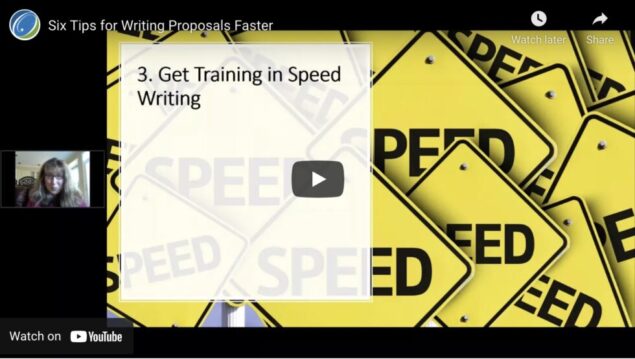Everyone knows that if you don’t bid, you don’t win. There is much to be said about a thorough capture and bid-no-bid process, but companies that grow aggressively also write lots of proposals. If your goal is to submit more bids, then you must figure out how to write proposals faster. Here are six tips on how to write faster and better proposals. You can either watch the video above or read the article below (or both).
1. Get cross-trained in all proposal disciplines.
To be a well-rounded proposal expert, you need to study all aspects of the profession. It includes proposal management, writing, editing, graphics, desktop publishing, and capture (especially win themes and solution development). This way, you will have the skills to be a good leader to your proposal team, perform well in any situation, and significantly impact your Pwin through compelling and compliant content. You also want to understand enough about the other half of developing winning proposals: price, and the elements of writing a winning cost proposal. We have proposal training courses for all of these subjects in our Bid & Proposal Academy.
As you develop your skills, you will be able to tackle many tasks in a single pass that normally take multiple specialized proposal professionals to complete. For example, you could edit and desktop-publish at the same time, or you could edit the graphics instead of marking them up and sending them to the graphic artist, then proofing them again, and so on. It saves a lot of time in coordination and reduces the risk of miscommunication.
Unless you are the one-stop-shop proposal manager and your company doesn’t have any other proposal resources, all this cross-training is not to pile on more workload. You do it so that you can fix things faster and become more knowledgeable and efficient at your tasks.
Additionally, many proposal professionals in large companies get cross-trained to prevent burnout. After several proposals in a row, it’s nice to be able to run capture on opportunities that have a slower operational tempo. Conversely, capture managers are cross-trained in proposals so they can understand how their preparation and capture artifacts get used in proposals. Understanding what it takes to develop a winning proposal is key to becoming a great capture manager.
2. Get the help of the Subject Matter Experts (SME)
Proposal managers tackle many challenges, but usually, they are not expected to develop the proposed solution and content unless they are SMEs. The best proposal managers are SMEs at becoming SMEs, but your job is to make content more compelling, not generate it from scratch or from boilerplate. You need help from your team with this task. However, we have found over the years that many proposal managers struggle with getting support from technical staff. Sometimes it happens because the company is bidding on a contract where they have limited technical expertise, and the team does not have the right experts. Other times, the company has the right experts, but they are unavailable for proposal support.
Our tip is to ensure that your company’s leadership provides the right motivation for SMEs to support your proposal effort. This could be the carrot or the stick. The carrot is to compensate SMEs for writing proposals with money or time off, and the stick is to set expectations for SMEs to contribute to proposals as part of their jobs. Don’t let your leadership be cheap or weak by always picking up the slack for SMEs or faking it. It will negatively impact your confidence in your ability to lead a winning proposal effort when your company suffers frequent losses.
3. Get training in speed writing
Most people are not taught how to write proposals, so they write incorrectly. A backward, convoluted proposal writing process leads to painful writing experiences. Many proposal writers write a sentence, edit that sentence, stop, research, come back, correct, rewrite, berate themselves, and procrastinate. The problem with a typical proposal team is that the proposal manager doesn’t know how to write fast, which means they cannot teach their SMEs how to write either. The entire team burns the midnight oil, going through a painful process of procrastinating, then gaining some momentum, then losing it again. If you are going to be friends with procrastination, then get our free Proposal Procrastination Flowchart so you do it like a pro. And, consider investing in our Writing Persuasive Federal Proposals class to learn how to write persuasive proposals faster, and train your SMEs on how to write to prevent yourself from rewriting the proposal.
4. Think pre-built
The more you build in advance, the less time you will need to spend after the Request for Proposal (RFP) is out. To save time, create a set of process tools and management templates you can use during every proposal. For example, it should include all the forms you use for proposal management, such as the RFP distribution list, collection of questions for the RFP, tracking matrixes, compliance matrix, proposal status meeting agenda, proposal schedule, your proposal kickoff brief template, style guide, Pink Team kickoff and debrief, Red Team kickoff and debrief, and so on. If you have everything organized at your fingertips, you won’t have to fish in recent proposal folders to figure out what you want to reuse, and you won’t risk having left-over artifacts from the old proposal embarrass you during meetings. Pre-build a proposal template in Word, where you have pre-programmed all the styles. Set your default Paste rules to “Keep Text Only” to prevent importing styles from the Internet or boilerplate materials from other proposal contributors. Set up a style for fancy tables, so that they appear with a single click. Create an attractive cover, a pre-settable of contents and figures, and so on. Create and use a library of easily modifiable graphics. Easily modifiable means graphics created in Microsoft PowerPoint that don’t require editing by a proposal graphics artist using Adobe Illustrator or Photoshop. A good artist can create attractive graphics with any tool, and PowerPoint has become significantly more powerful. Don’t hesitate to make the switch if you still think that Adobe is the only way to go, but your graphics budget is low. If you cut out steps in developing graphics and make easy changes yourself, then you can get more done in less time.
5. Use Checklists for everything
Checklists for repeated tasks are important even for seasoned professionals. This is why pilots with thousands of flight hours use checklists for everything: “before takeoff,” “cruise,” “pre-descent,” “in-range”, and so on. Checklists virtually eliminate mistakes and oversights – and just like in aviation, the proposal profession places a tremendous responsibility on the proposal manager’s shoulders. Although not a matter of literal life and death, a proposal outcome determines the company’s and its employees’ livelihoods. We recommend using a set of checklists for the proposal management process. For example, we use a checklist for RFP analysis, pre-kickoff preparations, data call issuance, day-to-day management, review preparations, and proposal printing and delivery. You can get your own copy of A Proposal Manager’s Essential Checklists to help you with managing your proposals as well.
We use another set of checklists for content development. These checklists help eliminate tangents during solution brainstorming meetings where participants may freewheel through topics for hours without producing usable proposal material. The checklists for management and technical sections help structure the discussion and remind your SMEs about successful solutions offered before. These checklists need to be tailored to your set of offerings and be updated with each original solution you develop. They form a powerful framework for writing proposals faster. You can get a sample copy of technical and management solution checklists in our Advanced Capture Management.
6. Get the right tools in place
These days, when we have an app on our smartphones for nearly everything, surprisingly few tools make it into the world of proposals. Although this could be a huge article of its own, we will focus on just a few most important ones.
Use collaboration suite to automate administrative tasks in proposal management. If you run proposals off of email, you are either a team of one or two people, or you are stuck in the past century. These days, Microsoft SharePoint and OneDrive come standard with professional Office. However, dozens of other superb collaboration platforms such as iMeet Central exist to help manage version control, simultaneous proposal writing and reviews, communication, workflows, and other proposal tasks that can take up to forty percent of a proposal manager’s time. Ensure your collaboration suite is properly configured and your proposal team is trained on how to use it.
Develop a proposal content library you can reuse in addition to your checklists. Include your old proposals, reusable proposal content, graphics library, past performance library, resume, various plan templates, “golden nuggets” about your company, and other proposal assembly line components. Keep your library up to date by dedicating one of your staff members to maintain it.
Use mind mapping tools for brainstorming by yourself or in a group. Our favorites are Mindjet and xMind. Mind mapping tools have rich uses in proposals, from analyzing an RFP to outlining, to brainstorming on solutions and proposal win themes.
Finally, consider using proposal software that automates some portions of the proposal development process. Make sure it can fetch content from your proposal library. It must work well with Microsoft Word and not distort formatting when you try to change the document outside of the software. It should be also easy to use, as it must save you time instead of causing headaches.
With all of these components in place, you will be well on your way to writing proposals faster. If you need any business development, capture, or proposal consulting help, email us at [email protected]
Contact us to learn more.

